An Intern at The Met: When Science Meets Art
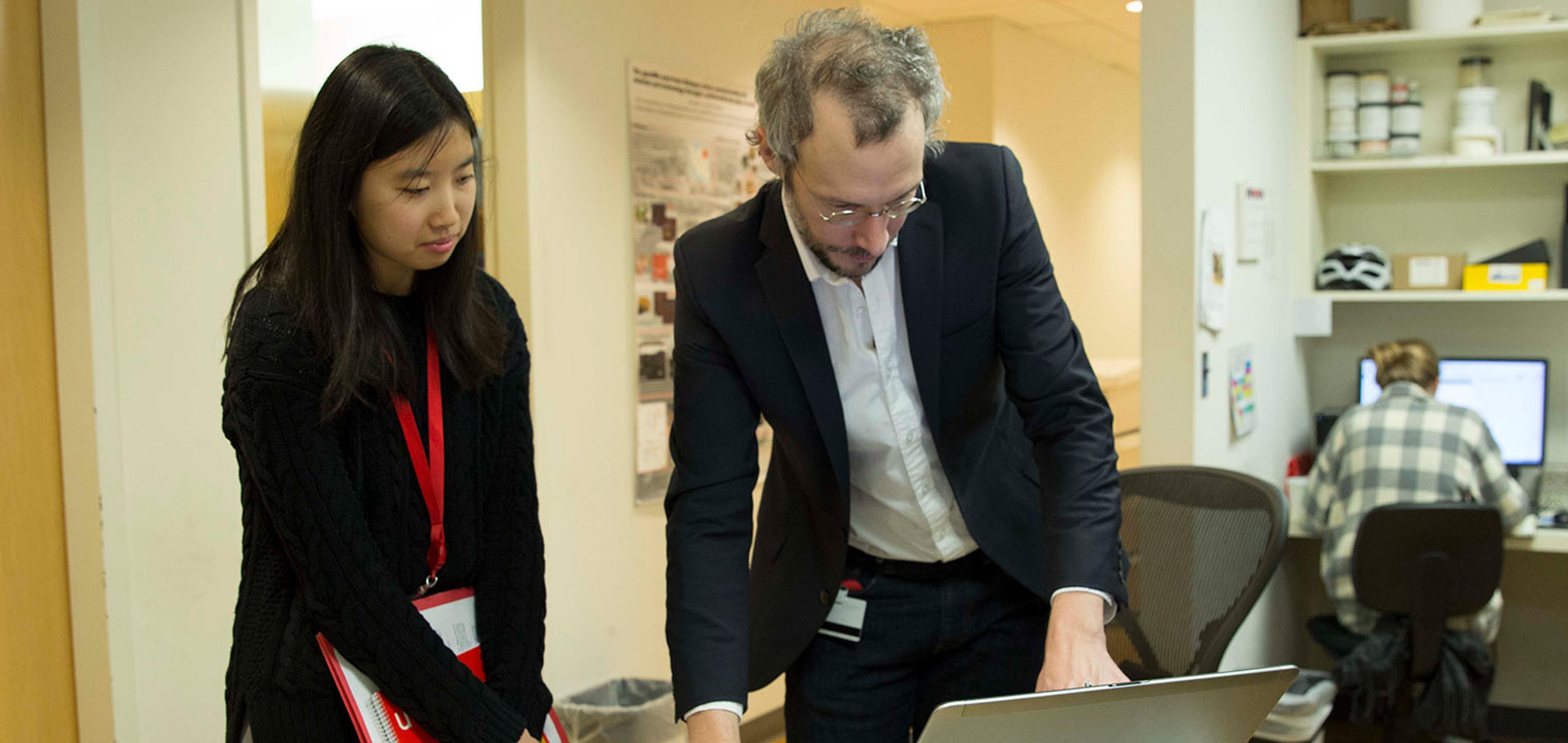
Tiffany Li, fomer undergraduate intern, and Federico Carò, associate research scientist, in the Department of Scientific Research lab. All photos by Skyla Choi
During my recent internship in the Digital Department, I was astounded by the range of fields that The Met is involved in. As a biomedical engineering major, my background is in science and engineering, but I'm also interested in fields within the humanities, especially art and history. A primary motivation for my desire to intern at The Met was to be a part of its interdisciplinary environment, and to learn more about how science and art can come together, as they do both in Digital and in the Museum's many conservation departments.
I was particularly interested in the Department of Scientific Research. I knew the department was responsible for supporting conservators and curators by investigating the material aspects of works of art in The Met collection. But I had only a vague, general understanding of the department's role and work. So I went down to the Scientific Research labs to find out more for myself. I spoke to three scientists, each with different specialties and research interests, to hear their thoughts on the role of scientific research within a museum setting.
Federico Carò
"Passion brought me here at the end, but the journey was very complicated," says Federico Carò, when I ask him what brought him to The Met. Born and educated in Italy, Federico first pursued a career in academia, using his knowledge of geology to understand how certain materials became art. He then was granted a fellowship to study Southeast Asian stone materials at The Met, and worked at the Freer-Sackler Gallery in Washington, DC, for one year before returning to The Met in a permanent position as an associate research scientist specializing in geology.
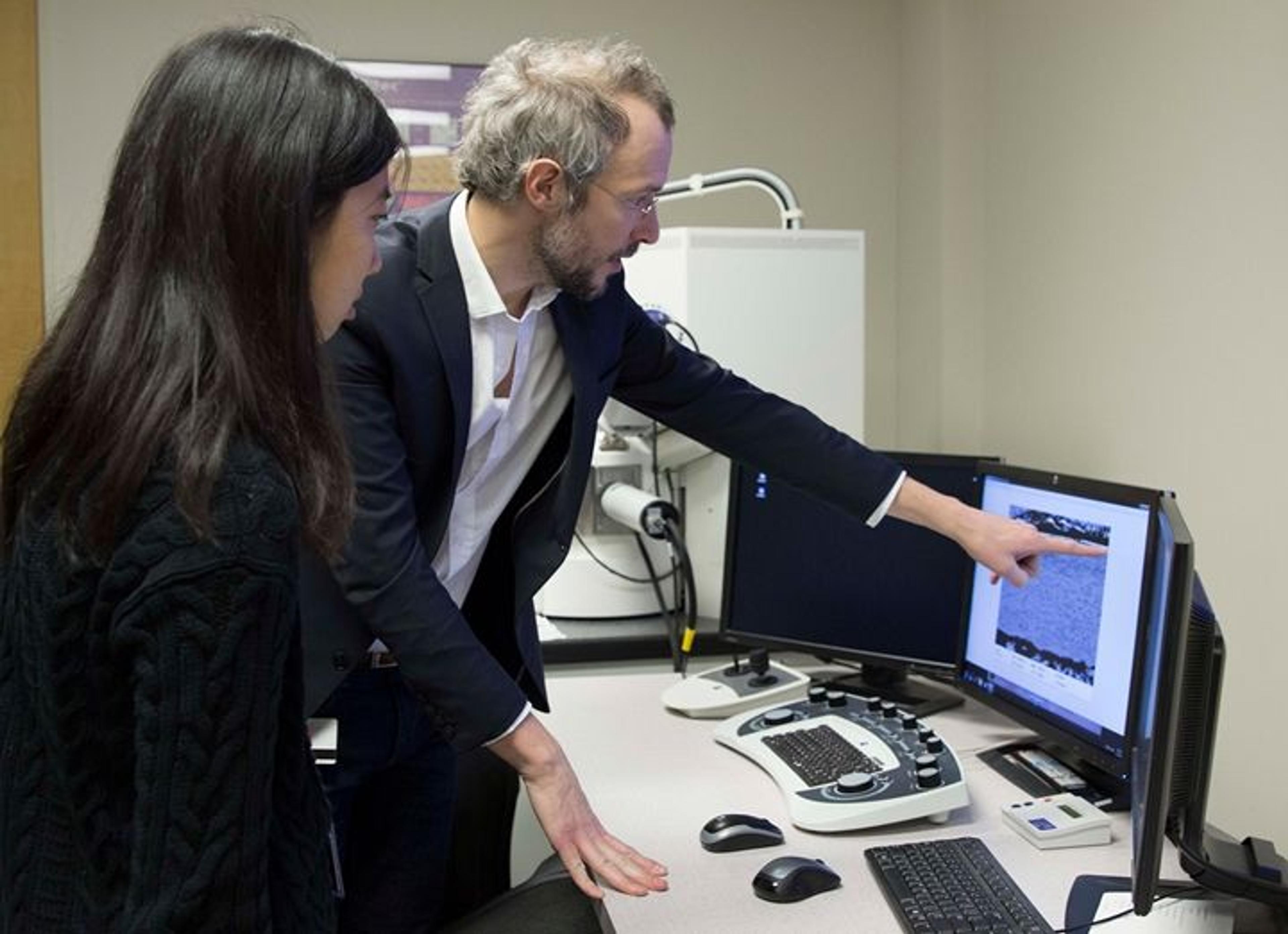
Federico Carò explains his research to Tiffany Li
We start by talking about Federico's research, as well as the work of the Department of Scientific Research as a whole. One area of departmental research supports conservators by providing information about objects' constituent materials, as well as about restoration materials that may have been used in the past. Another area supports curators, helping them to contextualize an object within an exhibition or to clarify provenance issues. The technical information that the department provides often ends up in the catalogue or in the labels that complement the art-historical information. Finally, the scientists have individual research projects, which invariably complement The Met collection.
Federico discusses one such research project, which was the focus of his fellowship at The Met. As a fellow, he studied stone materials used during the Khmer empire (modern-day Cambodia) from the sixth to the fourteenth century. "To help in understanding the provenance of such sculptures, I flew to Cambodia multiple times and visited ancient quarries to work more directly with the materials."
A more recent project, in collaboration with French archaeologists, involves the study of the technical ceramics and furnaces excavated from a bronze foundry discovered at the Royal Palace of Angkor Thom (Cambodia). "In this research I'm not studying Met objects directly, but I'm working on the material that was most likely used to cast some of the sculptures that we have here in our collection," he explains. "It helps and will help answer many questions regarding how these bronze masterpieces were fabricated, and by whom."

Bust of Hevajra, late 12th–early 13th century. Cambodia, Angkor period. Stone, H. 52 in., W. 29 in (H. 132.1 cm, W. 73.7 cm). The Metropolitan Museum of Art, New York, Fletcher Fund, 1936 (36.96.4)
Federico describes one discovery related to the sculptures of deities in the Southeast Asian galleries at The Met. Some of these stone sculptures were originally located within shrines, while others, such as the figures of guardians, were installed outside and on the way to the shrine. Federico and a team of scientists determined that for the sculptures outside the shrines, one particular type of stone was used, similar to the one used for the buildings, while the deities themselves were made using a different stone that often was less easily available at the site. From this, and by studying the distribution of stone types within different temple complexes, the scientists and archaeologists hypothesized that the use of a specific stone was not just a technical but also a cultural choice, possibly dictated by the special status of the sculptures installed within the shrines.
The cultural implications revealed by studying the stones went beyond this one application. "By knowing where the stone was physically taken, and how that relates to where the capital of the empire was, or which king was there at the time, you can actually help in answering questions about economy and trade routes and the movement of materials." Research like this supplements the work of curators and provides valuable information about art history and culture.
Naturally, my next question was how one would go about determining the composition of a stone. "The characterization of stone materials is achieved by combining different analytical techniques, which could be both invasive and non-invasive," Federico says.

Left: X-ray fluorescence spectrometer. Right: Scanning electron microscope
Among the non-invasive techniques, one of the most popular in museum studies is X-ray fluorescence spectrometry. This technique takes advantage of the interaction between a finely collimated X-ray beam and the object under investigation. When X-rays interact with the surface of an object, other X-rays fluoresce back and are detected and measured by a spectrometer. Because every atom in the object emits X-rays with specific energies depending on the element, it's possible to derive the elemental composition of an object without taking a sample. This analysis is harmless to works of art, which is an important requirement in working with museum objects, many of which are thousands of years old and cannot be altered lightly.
Another technique used by scientists at The Met is scanning electron microscopy. With a scanning electron microscope, it is possible to collect highly magnified images of the surface of objects or samples, as well as information on their elemental composition, by using a focused beam of electron inside a vacuum chamber.
Eric Breitung
Senior Research Scientist Eric Breitung focuses on modern preservation materials and museum environment issues. Unlike Federico, most of his work does not directly involve artwork. Instead, his work day typically falls into three categories: advising conservators and collections managers on aspects of the museum environment such as light, temperature, and humidity levels; researching novel test methods for assessing materials used to display, ship, and store objects in The Met collection; and working with colleagues in the design, curatorial, and conservation departments to select appropriate display materials for upcoming exhibitions. Although he is not working directly on the artwork, his work on modern preservation materials and museum environment issues has large implications for The Met collection.
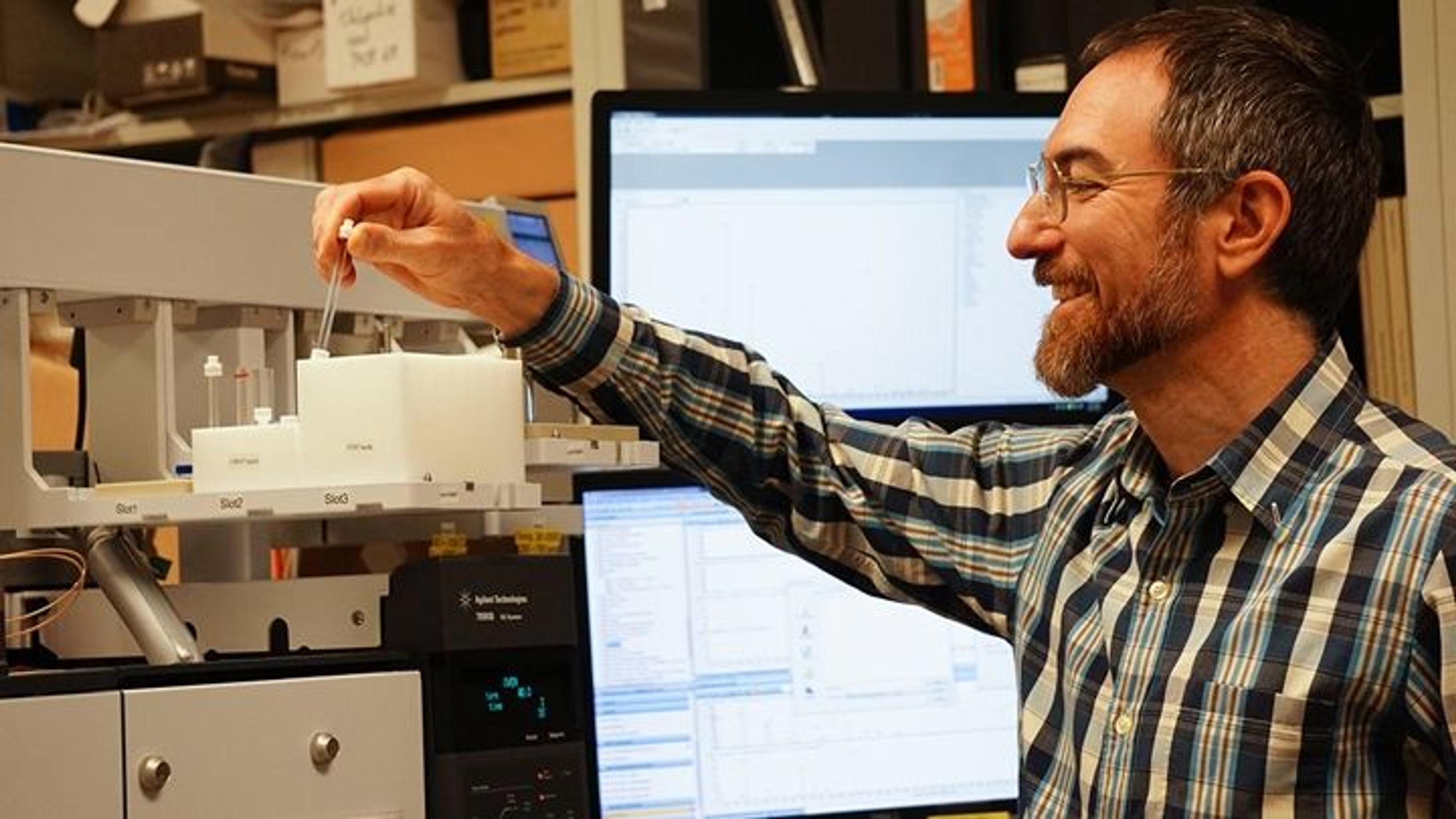
Eric Breitung in the lab
Like Federico, Eric has a scientific background. He has used his PhD in physical organic chemistry to address a variety of surface science questions both in industry and cultural heritage institutions. While at General Electric (GE), Eric's work focused on thin film, coatings, and polymers, which he has applied to the development of anti-tarnish coatings for silver objects at The Met. When I ask him how being at The Met compares to being at GE, Eric praises both organizations highly for their passionate and driven people, who truly care about what they are doing. "I transitioned from industry to cultural heritage science, because I was impressed by the range of scientific challenges in this field. It was exciting to be able to apply the skills I'd developed at GE to the art world. Walking through The Met's galleries to attend meetings with colleagues is also a great perk."
Now a research assistant brings out a glass jar with small coupons of metals hanging from the top of what looks like a 3D-printed holder placed across the neck of the jar.
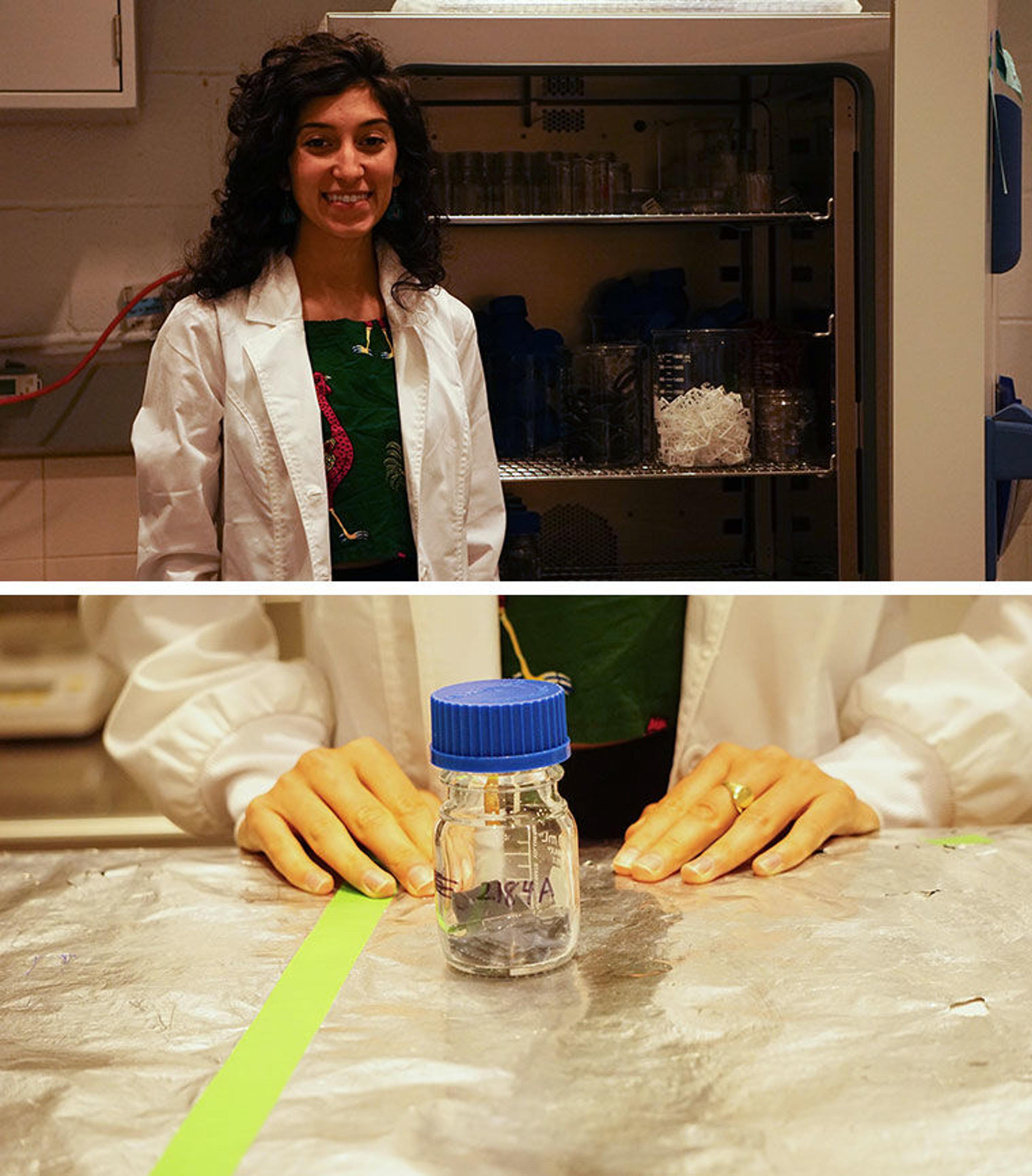
Top: Research Assistant Isabella Buscarino. Bottom: An Oddy jar
Eric explains that this is the Oddy Test, an accelerated aging test that can reveal if a material off-gases something that may corrode certain metals. Invented in Britain, the test was originally developed to determine why Andrew Oddy's coin collection, which he had left in a wooden cabinet, had become corroded, turning green and black. The test uses the metal coupons as surrogates for artifacts and is well suited for understanding the potential effects of materials on leads, bronzes, and silvers. The same results are also typically used to guide decisions about non-metallic artist materials, such as leather, paper, fabrics, wood, and so on. Since it is unclear whether metals are appropriate surrogates for these types of artist's materials, Eric is developing a test that may be more appropriate for non-metallic objects. He is doing this by aging materials with paper instead of metal coupons, and hopes to determine whether and to what degree the materials that corrode metals are the same as those that degrade paper.
In his work on museum environment issues, Eric works with a range of people, such as the manufacturers who make the fabrics used in gallery displays. Eric explains that acetic acid was recently found in varying amounts in these display fabrics.
"Acetic acid is just vinegar, so it should come out if you rinse it in water," Eric says. "But adding the acid is part of the manufacturer's dyeing process, something my colleagues Catherine Stephens and Nancy Britton established. The manufacturer neutralizes an alkaline dye with an acid, and the excess acid gets entrained in the fabric." However, if the fabrics are washed with soap and water and then rinsed heavily afterwards, the amount of acetic acid can be reduced to the point where the fabric is much safer to use with art.
"This kind of testing and investigation enables us to advise conservators and designers on what materials are safest for the art," he continues. "In ordering from this company, for example, we advise them to request that the fabric be washed with detergent and rinsed before shipping. Since The Met and many other museums use fabric in nearly every exhibition, this ended up being a very useful discovery."
Julie Arslanoglu
Research Scientist Julie Arslanoglu describes her background as "organic synthetic chemistry." Her field is the most similar to mine, and I enjoy hearing about her research at the National Cancer Institute at the National Institutes of Health, and at the University of Texas Health Science Center at San Antonio, on a class of enzymes called cytochrome P450. Then, just as she started to lose her passion for that type of research, a friend who worked in a paintings conservation studio told her about conservation. "I walked in and I just fell in love with it," Julie says. "The things you did, which were driven by the chemical composition of the art, had immediate results."
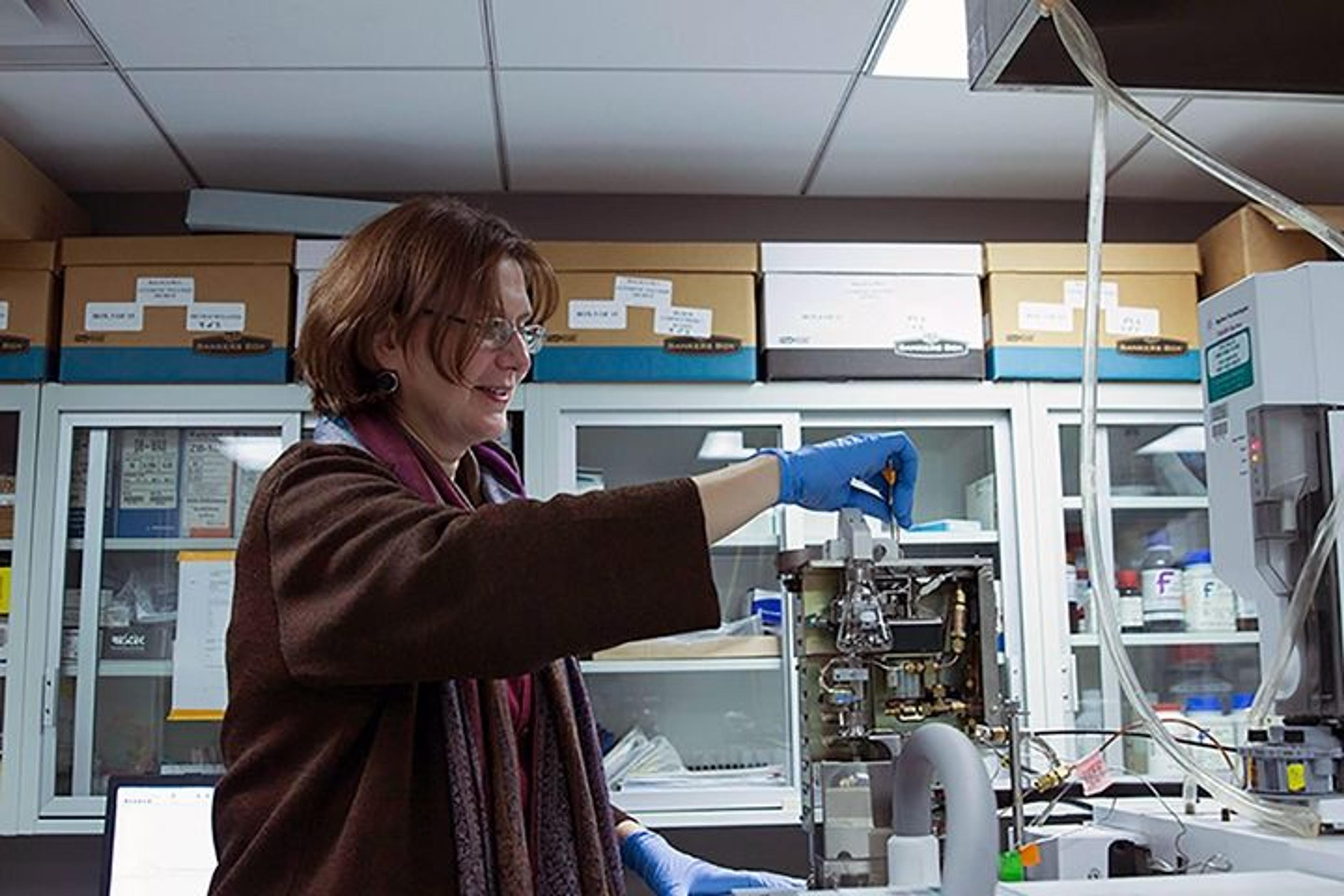
Research scientist Julie Arslanoglu in the lab
After spending one year as a fellow at the Smithsonian, obtaining a post-graduate degree in paintings conservation from the Cortauld Institute of Art (London), and working at museums in London and in California, she ultimately joined The Met as a research scientist.
Our conversation quickly becomes highly technical, but Julie walks me through everything. A lot of her work is with organic materials—specifically, paints—and her office is suitably near the Department of Paintings Conservation. Paint, she explains, can be composed of a lot of different materials, but it has to have a pigment and a binder. "The binder could be pretty much almost anything. In the earliest rock wall paintings, it could sometimes be animal fat, saliva, glue, or blood. As you move through time, collagen-based or glue-based paints were prevalent. Then it transitioned to egg and whole egg tempera, and then, in the mid-twentieth century, to modified oils and synthetic binders."
I bring up something Eric had mentioned—that a lot of oil paintings had apparently been forming soaps. Julie acknowledges this. "One of the key things to remember about art is that it's not stagnant," she says. "It's not like you make it and it stays exactly the same way it is for all eternity. All art is made up of chemical compounds and they react. So soap formation is a natural reaction of the oil substrate with pigments that are present in the paint."
That reaction occurs as paint dries and time passes. Oil paints dry through a combination of oxidation and hydrolysis, resulting in the formation of a polymeric network containing triglycerides and fatty acids and stabilized by the ions from pigments. As oxidation and hydrolysis continue through time, the polymeric network breaks down into smaller carboxylic (fatty acid and diacid) fragments that react with metal ions to form complexes known as soaps. These complexes can migrate through the paint film and aggregate as they move to a more stable energy state. Once they aggregate to a large enough size, they start to become visible.

Francesco Granacci (Italian, 1469–1543). Scenes from the Life of Saint John the Baptist, ca. 1506–7. Tempera, oil, and gold on wood, 30 5/8 x 59 1/2 in. (77.6 x 151.1 cm). The Metropolitan Museum of Art, New York, Purchase, Gwynne Andrews, Harris Brisbane Dick, Dodge, Fletcher, and Rogers Funds, funds from various donors, Ella Morris de Peyster Gift, Mrs. Donald Oenslager Gift, and Gifts in memory of Robert Lehman, 1970 (1970.134.1)
These chemical reactions have two results. First, the paint becomes more transparent, because the refractive index of the binding media changes. "If you look at Dutch landscape scenes in the sixteenth century that are on panels and have beautiful blue skies," Julie says, "sometimes you can see the wood grain coming through. That is because the paint is now more transparent." Second, the soap aggregates can grow large enough to cause a change in surface texture, as they have in the painting above. The transparent spherical aggregates may push out through the paint, appearing as bumps; and, if the painting has been cleaned, one may find that these aggregates have been removed, leaving depressions that trap surface grime or darkened varnish and appear as small black dots.
Although conservators have observed these phenomena for a long time, a focused research effort in the last twenty years allowed this soap formation process to be understood better. But according to Julie, a mystery still remains. "Why does this happen in the first place? Why do some paintings exhibit no aggregation?"
Scientists around the world, including Silvia Centeno, Julie's colleague in the Department of Scientific Research, are involved in focused research projects to look at the chemical mechanism of soap formation in order to understand what drives the formation of these soaps. Understanding and possibly preventing the process is the aim, rather than reversing it, Julie explains, partly because of a lack of feasibility to reverse the reaction, and partly because of the ethical issues that come with potentially driving other reactions within the entire painting.
A significant development resulting from Julie's research was a new application of ELISA, a common biochemistry procedure used to detect a substance. Julie and her colleagues in the Department of Scientific Research modified the typical ELISA to identify proteins that are typically found in artworks.
"It's a simple procedure," she says. "You take a single extraction from a paint sample and then test it using different antibodies, each for a specific protein. By analyzing the antibodies, the test can tell you, for example, that collagen is present, which means you must have animal glue, or casein, which means that the binder for the paint is milk-based." In collaboration with Rutgers University, Julie has applied the ELISA technique directly to paint cross-sections that are prepared in a resin block. The unique reporting system combines nanoparticles with a phenomenon called surface-enhanced Raman scattering in order to allow the simultaneous identification of a protein as well as its location within a multilayered cross-section. "You find out not only what protein you have, but exactly where it is, by where your antibody is binding."
I asked Julie how the technologies that she and her colleagues use can transform our understanding of artworks at The Met. "The implications are huge," she says. "Take the example of mass spectrometry. Today we can do studies with Egyptian artworks that are millennia old and we can say, 'Yes, the Egyptian literature says that this paint binder has to be acacia gum. But our analysis shows that although it is a type of gum, it's not acacia.' And that's transformative within the lexicon of Egyptian research."
Common Themes
As I spoke to these scientists, I found that they had certain shared experiences and similar approaches to their work, despite working on different research projects.

Julie Arslanoglu, Eric Breitung, and Federico Carò
All three scientists value collaboration across the Museum, the country, and the world. Eric remarks that he has a good ongoing collaboration with conservators at the Rijksmuseum in Amsterdam. "People at museums are really willing and interested in collaborating and talking," he notes. Federico agrees, observing that in academia there may be competition between departments and between individual researchers, while "here we all have the goal of supporting the collection." Julie is involved in collaborative work with Columbia University, Rutgers University, and the University of Bordeaux in France. And all three scientists work with museums across America, since The Met is one of the few museums that has the broad range of tools and resources that are required to study many objects.
All three also acknowledge how fortunate they are to be at The Met. Federico attributes it in large part to luck, and Eric agrees. Julie remembers that when she was considering making the switch from biochemical science to conservation science, she visited scientists in American museums who told her that there were no jobs, saying, "If you want to do science, do science. Don't get involved in art." "But I did it anyway," she says, "and I'm so happy I did." Yet while luck may have played a role, as luck does in any career, it's clear that their talents, as well as their interests in the arts, led them towards their science research roles at The Met.
Each scientist has always had a connection to art. Eric recalls that during graduate school, he pursued a variety of creative projects with friends in the fine arts department, and he continues to enjoy collaborating with local artists. Julie took fine art and art history courses when she studied paintings conservation, and Federico remembers how much he always enjoyed painting, drawing, and the arts, although he never took a class. "When I was a teenager in high school, I loved painting. My parents had a friend who was a successful painter and chemist. I remember I went to his studio and helped him with pigments, and he started talking about the chemistry of painting. He said, 'If you want to become a painter, you have to understand the properties of pigments,' which was totally right."
Eric also mentions that there used to be a researcher at The Met who focused on biological applications, examining, for example, the effect of different molds on paper. I had always thought of the role of science in art as limited to the physical sciences, such as chemistry or geology, so I was excited to learn that biology, the science most directly related to my interests, could also be involved. I also learned that the fields of conservation and scientific research are growing in scope, so the range of techniques and the scientific disciplines that can impact art are expanding.
My time at The Met has drawn to a close, but as I think about where I'm headed next, I'm excited to know that there are so many possibilities within art, science, and engineering that go beyond traditional conceptions and more common career paths. I'm also happy to know that in all the museums I've visited and the ones I continue to visit, there are scientists working behind the scenes, studying the objects to learn more about their original purpose and identity, and keeping them as intact as possible for future visitors.
Tiffany undefined
Tiffany is a member of the Museum's Teen Advisory Group.